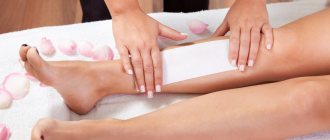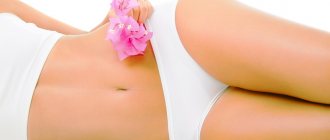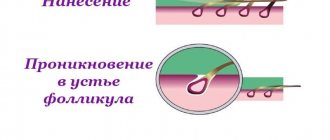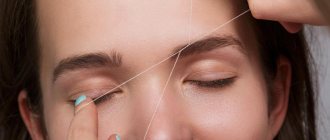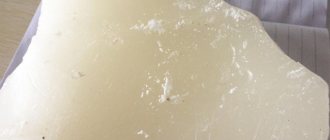Every girl wants to be attractive and does everything possible for this. An integral part of caring for your body is hand hair removal.
There are a large number of types of hair removal and salons that offer this procedure, while prices and quality of care work vary greatly.
But this procedure can easily be performed at home, following the recommendations given in this article. Did you know?
Since ancient times, hair removal in the East has been considered a sign of good taste and aesthetics. It was Eastern trends that brought this procedure to European countries.
Brief description of the procedure
Hand waxing is the most popular procedure compared to other types of hair removal, because it allows you to remove hair for a fairly long period without requiring much effort or high costs.
The process itself consists of using warm wax or wax strips to remove hair on the hands, which are glued to problem areas and the hair is removed with a sharp movement.
What is waxing
Waxing is a procedure for removing unwanted hair using melted wax. It is carried out in any area where it is necessary. The vegetation is effectively pulled out along with the hardened wax mass. There are several types of waxing depending on the method of hair removal: using strips or manually.
Female representatives have always thought about smooth and soft skin and made it so with the means at hand. Among many other cosmetic procedures, this one was born earlier than the others.
Initially, wax hair removal was intended for the bikini area due to its deep impact on the hairs. Also, its advantage is that it does not cause irritation and cuts in sensitive intimate areas.
Recommended articles on the topic:
- Laser stretch mark removal in a beauty salon: pros and cons of the procedure
- Thermal detoxification: lightness of the body and clear skin
- Laser scar resurfacing is a modern way to get rid of skin imperfections
Brazil is considered to be the birthplace of waxing. In this regard, its variety, Brazilian waxing, is widespread in many countries. Previously, the procedure implied the complete removal of unwanted vegetation. Over time, it has been modernized, and now, with the help of deep bikini waxing, you can make a fashionable decorative haircut in an intimate area.
Currently, there are several styles of its implementation:
- American. Hair is removed only along the borders of the swimsuit. Everything hidden underneath remains untouched
.
- French. The style is similar to the American one, but in this case the area of hair elimination is slightly wider.
- Brazilian. Involves complete removal of vegetation. In some places they may not be removed and left as decoration.
- Full Brazilian. Maximum removal of unwanted hair during waxing.
The waxing procedure is especially effective when using inhibitors that affect the growth of bristles. They are sold in the form of a cream or lotion and contain extracts of natural origin that help slow down the division and maturation of follicle cells. As a result, unwanted hairs take longer to grow, which means sessions can be performed less frequently.
Professionals use the material in various forms depending on the work area. When removing vegetation over a large area, such as the legs or back, it is advisable to use a wax melting cartridge during waxing. If the area is small, it is better to give preference to baths or a spatula.
Waxing can be carried out using special strips made of fabric or paper. The principle of their operation is simple: stick the strip on the work area in the direction of hair growth. Wait a few seconds and with a sharp movement remove it from the skin along with the bristles. This is how home waxing is most often done.
Please note that hair removal using resin or strips is carried out strictly against their growth. Otherwise, not all vegetation will be removed. If after the procedure there are unwanted specimens left, it is not recommended to remove them again. With additional exposure to the skin, the likelihood of irritation and swelling increases.
Types of hand hair removal
Hand waxing is a popular type of body care that can be done in two ways:
- cold
- hot
Using strips
For cold hair removal, special strips are used, which can be purchased in the store. They consist of a fabric base and a thin layer of cold wax. The strips are very easy to use and are considered quite effective.
Of course, each manufacturing company tries to make them of higher quality and at the same time accessible to different segments of the population, so there is a huge selection of this product.
Strips for waxing hands have an elongated rectangular shape, lubricated with wax on one side, which is attached to the skin area and smoothed out well for better adhesion to the hair. Then it comes off sharply, parallel to the hand. The procedure is repeated until the hair is completely removed.
Hot wax
This procedure using hot wax is considered more effective than using cold wax and is more often performed in salons. But now it can also be done at home. On store shelves you can often find jars of wax and fabric strips that are useful for this type of depilation.
The procedure is quite simple. Initially, the wax that is in the jar is heated in a water bath or in the microwave so that it becomes liquid and can be easily applied to the problem area. There are also inexpensive special heaters for wax.
You need to heat it in the manufacturer's jar; it can withstand high temperatures.
The composition of the jar is applied to the hair, the strip is glued and then removed with a sharp movement against the hair growth. Important!
Be careful when applying melted wax to your skin because it can cause burns if it is not cooled to the appropriate temperature. Check the temperature by dropping a little mixture on your wrist; if it does not cause discomfort, then you can proceed with the procedure.
Manufacturers care about the safety of using hot wax and the set often includes an indicator spatula, which, when mixing the contents, notifies the user whether it is ready for use. It is also easy to apply the contents to the skin with this spatula; it has its own curve on different sides, which is suitable for different areas.
Security measures
Waxing will become as safe as possible and will not pose a threat to skin health if you follow the recommendations of specialists, namely:
- on the day of the procedure, you should not use any creams, as this may complicate hair removal;
- After waxing, you need to wear clothes made from natural fabrics. Synthetic fibers do not allow air to pass through, the body begins to sweat a lot, and droplets of sweat are an ideal breeding ground for microorganisms that can easily penetrate the skin injured after the procedure;
- You should not wear clothes with narrow, tight sleeves, otherwise there is a high probability that pathological changes in the direction of hair growth will appear, i.e. hairs will grow in;
- within 12 hours after waxing, creams and lotions should not be applied to the skin so as not to provoke inflammatory processes;
- during the first 24 hours, do not visit saunas, swimming pools, or gyms, since in these places pathogenic microflora can enter through the injured skin layer;
- Do not expose your hands to direct sunlight for the first 2-3 days.
Features of hair removal at home
Like any other type of hair removal procedure, hand waxing has its own differences and characteristics. In order to carry out this procedure yourself correctly and as comfortably as possible, you need to know some of the subtleties of this process.
What you will need
Items you will need for waxing depend on the type of procedure:
- If you plan to use strips, then in addition to them you also need to have special napkins with which wax residues can be easily removed from the skin. Most often they are already included with the strips. It is also very important to stock up on sedatives that you will definitely need after the procedure.
- If you purchased liquid wax, then to use it you need a spatula, with which you mix the contents while heating, and fabric strips. This all comes complete with wax. But there are times when you need to purchase everything separately. Therefore, pay attention to the packaging, which contains information about the contents of the set.
There are also wax cartridges. They are only used in conjunction with a stand, which operates on mains power and melts the contents. Cartridges are sold separately and can be replaced. In this case, additional necessary items must be purchased separately. For this type of hand waxing, you do not need a spatula, since you apply the mixture using a cartridge, holding it in your hand and distributing the contents onto the problem area. When using this type of hair removal, purchase special napkins to remove wax residues and fabric strips.
Important!
Be careful when applying melted wax to your skin because it can cause burns if it is not cooled to the appropriate temperature. Check the temperature by dropping a little mixture on your wrist; if it does not cause discomfort, then you can proceed with the procedure.
Preparatory stage
In order for hand waxing to be effective and all unnecessary hairs to be removed, you need to prepare for it. The hair that needs to be removed must be at least 0.5 cm so that the wax will capture it well. The day before the procedure, you need to cleanse the area of dead skin using scrubbing. A hard washcloth, brewed coffee cake, or special store-bought body goods are good for this.
When carrying out evening water procedures, thoroughly steam the skin of your hands,
apply the scrub with light massaging movements and continue massaging movements for 1-2 minutes, then rinse with warm water .
Be sure to apply moisturizers to the cleansed area of skin upon completion. It is important that the moisturizer is completely absorbed into the skin or washed off well; if even a little of it remains on the hands, hair removal will be ineffective.
Also, one day before hair removal, you should not sunbathe, visit the solarium or sauna.
Rules for skin care after a session
Irritation often appears on the hands after waxing, so after the end of the session it is necessary to apply a soothing cream to the hands . It is not recommended to wear long sleeves for the first hour. Also, you should not use shower gels that contain chemical components; it is better to use regular baby soap for the first 24 hours after hair removal, and do not use a washcloth.
For two days after the procedure, you cannot scratch the skin of your hands, go to the sauna, take a hot bath, or visit the solarium. After two days, moisturize the skin with cream or lotion, and carry out this manipulation every other day.
It is necessary to scrub the skin before and after the procedure. After 5 days, scrub the skin again and moisturize. Scrub at least once a week. If the skin is prone to ingrown hairs, then you need to scrub 3 times a week, but if it is sensitive and dry, then manipulation should be done no more than once a week.
Possible consequences after the procedure
Waxing, like many other types of depilation, is a stressful procedure for the skin, since during the removal of wax, the skin receives microtraumas invisible to the eye. Waxing is usually accompanied by redness of the skin.
In addition, when hair is removed along with the follicle, the capillaries that supplied the hair root are broken. Therefore, red dots appear in places where hairs grew.
At the moment the wax strip is torn off, the skin of the hands must be stretched. If this is not done, bruises and bleeding may occur.
Sometimes when the wax is torn off, the hair is not pulled out along with the follicle, but breaks off. Subsequently, an ingrown hair appears from the damaged hair follicle, which can cause pustules to form on the skin.
If you do not clean and disinfect the skin before starting the procedure, there is a risk of microbes and bacteria entering the follicles, where they begin to multiply intensively and cause inflammation in the form of purulent pimples, boils, etc.
After exposure to wax, the skin of your hands becomes sensitive to ultraviolet radiation, and pigment spots may appear on it. To avoid this, in the first 2-3 days you need to protect your hands from direct sunlight by using sunscreen.
Step-by-step instructions for hair removal
To get a good result, consider step-by-step instructions on how to properly wax your arms up to the elbow:
- It is necessary to thoroughly wash the area of skin that is planned to be depilated. Then dry well with a towel, disinfect and degrease the skin with an alcohol-containing product;
- Heat the contents in the microwave or in a water bath;
- Sprinkle the area with baby powder or talc to prevent the wax from slipping off the hairs;
- Make sure that the temperature of the hand wax is not too high to begin the procedure;
- Apply the contents of the jar using a spatula in a thin layer along the hair growth;
- Quickly glue a fabric strip on top and smooth it with pressing movements;
- Quickly, with one jerk, against the growth of the hair, tear off the strip parallel to the hand.;
- There is no need to apply wax again to the same area if it is not possible to achieve perfect smoothness, so as not to injure the skin;
- Rinse with warm water or use a special napkin to remove wax residue (see other methods for removing wax after hair removal);
- Apply a sedative;
- If possible, you should use products that slow down hair growth.
Watch a video on how to wax your hands at home using a clear example.
How to care for your hands after waxing
To prevent waxing from being associated with unpleasant memories, the skin of your hands should be properly cared for after the procedure.
- Redness and red spots should be eliminated by applying soothing and cooling agents. These can be ready-made tonics, lotions, creams. Olive oil is good for these purposes.
- When acne and pustules appear, it is recommended to use anti-inflammatory and healing drugs of general action (Panthenol, Levomikol, Spasatel, Follivit), as well as creams or gels to eliminate acne on the face (Metrogil, Zinerit).
Levomekol ointment has an antimicrobial and healing effect - Ingrown hairs should be removed using a thin needle and tweezers, and then treat the damaged skin with an antiseptic (Miramistin, Chlorhexidine, hydrogen peroxide).
- Scrub your hands twice a week. This will remove the stratum corneum and facilitate the growth of new weakened hair outward, not inward.
- Apply a special lotion against ingrown hairs to the skin 2 times a week (Aravia Professional AHA-cream post-epil with AHA acids, Gloria Sugaring, Velvet cream-gel, Badyaga Forte gel, etc.).
Aravia Professional AHA-cream post-epil lotion contains fruit acids that dissolve the stratum corneum of the skin, helping new hairs to grow out freely
Comparison of prices and duration of effect with other methods
Compared to other types of hair removal, waxing is one of the most budget options. But despite this, to maintain the effect of smooth skin, this type of hair removal must be repeated every 2-3 weeks. The price varies from 200 to 300 rubles for hair removal up to the elbow and from 300 to 300 rubles for full arm hair removal.
Sugaring has the same effect as wax. The price range is the same as for waxing.
Laser hair removal is considered the most expensive, but also the most effective way to get rid of unwanted hairs. The downside is that the laser must be used up to 10 times to achieve the desired effect. One session costs from 1,800 rubles and more, depending on the salon and the method of laser hair removal.
Hand skin preparation
To ensure that the effect of wax depilation lasts longer and possible unpleasant consequences do not arise, the skin of your hands must be properly prepared before the procedure.
On the eve of waxing, it is recommended to treat the skin surface with a scrub. This will make it easier to pull out the hairs along with the follicles and prevent further ingrown hairs.
The skin of your hands can be steamed using a hot compress. This will increase the effectiveness of hair removal. Enough for 10–15 minutes. apply a towel soaked in hot water (50 °C) to your hands.
Immediately before the procedure, the skin should not only be cleaned of dirt and sebum, but also disinfected (for example, with chlorhexidine). This will prevent inflammation from occurring after waxing.
Pros and cons
pros
this procedure:
- an accessible and inexpensive way to get rid of hair;
- can be done at home;
- if you do the procedure regularly, your hair will become thinner, lighter and softer;
- It doesn't take much time.
Minuses:
- sensitive skin may become inflamed;
- you need to wait until the hairs grow to 5 mm;
- quite a painful procedure.
Important!
Be careful when applying melted wax to your skin because it can cause burns if it is not cooled to the appropriate temperature. Check the temperature by dropping a little mixture on your wrist; if it does not cause discomfort, then you can proceed with the procedure.
How is waxing done in a salon?
Stage 1. Preparation for the waxing procedure.
This is a stage that cannot be ignored, because the degree of pain and the final result depend on it.
Preparation should begin a few days before the expected date of waxing. Avoid using moisturizers that create a protective barrier on the skin. Scrub the work area three days in advance, which will help avoid ingrown hairs. Avoid a session during menstruation, general malaise or poor health - all these factors can increase painful sensations. It is not allowed to carry out chemical peeling of the skin before the procedure, and the first visit to a cosmetologist after the procedure is possible 10 days later.
Before waxing begins, the master will apply a product to the dermis that will minimize pain and improve the adhesion of hairs to wax.
Please note that the procedure is carried out only if the length of unwanted hairs is 5 mm or more.
Stage 2. Waxing.
When working with hot and warm wax, be sure to use rubber gloves.
Epilation with warm wax is performed using strips. You can purchase them in roll form and cut them before the procedure, or buy ready-made ones.
Have you ever experienced warm wax hair removal? Don't know how to do it correctly? Below we will consider the sequence of actions that must be followed to achieve a high-quality result.
- The wax resin is heated to approximately +50 °C. This can be done using a wax melter; the process will take about half an hour. Warm wax is most often sold in cartridges and with various additives in the form of chamomile, honey, algae, etc. If the material is hot or cold, the procedure will fail.
- The skin is treated with a special composition in the form of an emulsion, cream or lotion. A very popular emulsion based on menthol, which effectively minimizes pain.
- Wax is applied to the working area in the direction of hair growth, and a strip is applied to it. It is necessary to leave one edge of it free so that it is convenient to tear it off from the skin later. Hold the skin while removing hairs, this will help reduce pain. Unwanted hair on the knees and elbows should be removed correctly with the limbs in a bent position.
Please note that warm wax is applied strictly in one layer. Use only once per area; repeated application may cause burns or irritation.
- After waxing or hair removal, it is necessary to treat the skin with a special product in the form of lotion or milk. An emulsion is also great, but oils can clog pores.
Waxing with strips soaked in warm wax in the bikini area and armpits is not advisable. But this type of waxing is perfect for removing hair from the arms, legs, abdomen, back and even on the face.
Let's look at the stages of hair removal with hot wax:
- The material is initially sold in solid form. These can be tablets, cubes or granules. That is, it must first be heated. This can be done in a can wax melter at a temperature of +80 °C. Only in this case the wax will begin to melt and reach the desired temperature of +45...+60 °C.
- The duration of wax melting depends on its shape and composition and ranges from 3 to 15 minutes. As a result, you need to get the consistency of thick sour cream.
- Before the session, it is necessary to apply special products that have an antiseptic effect, for example, chlorhexidine, to the skin.
- To ensure that the material adheres well to the skin and unwanted hairs, use talc or baby powder. This will help reduce the amount of sweat and oil produced, thereby helping to remove even the smallest lint.
- The wax must first be applied to the wrist, checking that the temperature is comfortable.
- Using a special spatula, distribute the product evenly over the skin in the direction of hair growth. Three seconds are enough for the wax and bristles to interact. Having picked up the strip by the thick edge, you need to rip it off with a sharp movement of your hand in the direction opposite to the hair growth. In this case, the skin must be held.
If the layer of wax resin turns out to be too thin, it is possible to apply a second one. It can be applied no more than three times to the same work area. Waxing of the bikini area with strips of hot wax is carried out in small sections to reduce pain. If there are unwanted hairs left after the procedure, they can be removed with tweezers.
- Finally, baby powder or talc should be applied to the skin, and later an antiseptic, such as chlorhexidine. The latter should be continued to be used at home after each shower. These products will help completely remove wax residue.
We recommend
Laser hair removal of the upper lip: effective and reliable or expensive and useless?
Read more Hot resin waxing is great for removing unwanted hair in the bikini area, underarms and on the face.
Contraindications
The procedure cannot be performed if:
- a person has diabetes
- if there are moles, papillomas and warts in the area that is planned to be depilated.
- allergy to the components of the wax mixture.
- Many people are interested in the question of whether pregnant women can use wax to remove hair. During pregnancy, it is possible and safe to epilate your hands if the contents do not cause allergic reactions.
In conclusion, we can say that doing waxing at home is not at all difficult and much cheaper than in a salon. Therefore, after weighing all the pros and cons, following the instructions, choose the method you like and feel free to get down to business.
What are the benefits of waxing?
The waxing procedure is done quickly, and the result will please you for about a month. For this, many people loved her.
Let's look at the main advantages of waxing:
- Duration of the session. During waxing, large areas of skin are treated, unlike sugaring, so the process goes quickly.
- Efficiency. Despite the high speed of execution, the result can exceed all expectations.
- Cumulative effect. With each session, hairs will grow slower.
- Maximum painlessness. Achieved through the use of special means. Reduces the risk of irritation.
- Quality. With a professional approach, all unwanted hair will be removed.
- Wide application. Used for all types and shades of vegetation.
- Budgeting. The method of removal using wax is available to everyone.
- A small number of contraindications. Compared to analogues, for example, hardware hair removal, waxing is allowed even during oncological pathologies, individual intolerance to metal or the presence of metal implants.
- Possibility of dispensing with the razor.
- Getting rid of dead keratinized skin cells.
We recommend
Laser aesthetic cosmetology: the perfect technique for an ideal appearance Read more
Wax hair removal has not only a number of advantages, but also disadvantages. Let's look at them in more detail:
- Allergic reaction to wax. Before the first session, check this nuance with a specialist and conduct a test. If your allergy is confirmed, don’t worry, use sugaring.
- The appearance of ingrown hairs. This happens if the procedure is performed incorrectly. Choose proven professionals.
Despite all the advantages of waxing, it still has contraindications. The main one is the presence of varicose veins. Don't forget to ask all your questions to the specialist before the procedure. Be sure to take a test to determine intolerance to individual components.
In addition to the above, the main contraindications for waxing include:
- Skin diseases.
- Developing herpes.
- Diabetes.
- Individual intolerance to the components of the products.
- Presence of moles, papillomas, warts.
- Damage to the skin - scratches, cuts, inflammation.
- The period of pregnancy and breastfeeding.
Frequently asked questions about the waxing procedure
On the Internet you can come across false information about waxing techniques. We will dispel your doubts and answer the most popular questions.
- At what age can you do waxing?
There are no age restrictions. But the procedure can give poor results during hormonal changes in the body. This period most often lasts from adolescence to adulthood. If we take this into account, we are sure that the effect will certainly please you.
- How painful is waxing?
It is difficult to answer this question, since each person has their own pain threshold. For some, the manipulation is unbearable, while others feel nothing. In any case, do not forget that you can reduce pain by steaming your skin before the session. There is also the option of applying special products in the form of creams and sprays that have an anesthetic effect.
- Which areas can be waxed?
There are no restrictions here either. The waxing procedure is effective in any area. Let's look at them in more detail:
- The surface of the face, including the area above the upper lip, cheeks, and chin.
- Arms and legs.
- Bikini area.
- Chest and back.
- Abdomen area.
- Buttocks.
We do not recommend waxing in the area around the nipples, but there is no categorical prohibition on this either.
- How long will the effect last after waxing?
This is influenced by several factors. The approximate time during which the skin will remain perfectly smooth is 14 days. If the body is completely healthy and there are no disruptions in the endocrine system, the result can please you for about three weeks. In some cases, unwanted hairs may appear after 10 days.
Girls need to pay attention to the female cycle. It is not recommended to carry out the procedure during PMS and after its onset. During this period, the skin reacts very painfully to any external influences, and under the influence of hormones, hair growth can accelerate. The best time for resin hair removal is a couple of days after the end of your period.
What wax is used
To remove hair with wax at home, different formulations are used. You can now find several types of such products on sale. They are produced in cans, cartridges, granules or strips. It is easiest to use canned or film wax yourself. Cartridges need to be heated with a special device and are more difficult to use. Therefore, they are more often used in salons.
There are three options for waxing depending on the temperature of the wax. Hot, warm or cold wax can be used. All varieties have advantages and disadvantages, as well as application features.
Hot
Hot wax depilation is rarely done independently. It requires careful temperature control. Before use, it is heated to 600 with a special device. It is difficult to do this correctly on your own. If overheated, there is a possibility of burns. In addition, the composition has to be constantly warmed up, as it cools quickly. If you don’t have a special wax melter, you can put the jar in hot water.
With the help of hot wax, hairs are removed almost painlessly. After all, it penetrates into the pores, which expand due to heat. Therefore, it is often used for the bikini area, armpits, and face. With its help, even coarse hair is effectively removed. Hot waxing wax contains resins and essential oils. It gets very hot and penetrates the pores, so it cannot be used for any problems with blood vessels.
Warm
Warm wax is best used at home. It can be heated in a water bath. To control the temperature, use special test strips or control the heating with your hand - it should not be very hot. For the procedure, jarred or granulated wax is used, heated to a temperature of 40-500.
The composition for this procedure contains beeswax, pine resin, essential oils, honey. Substances are often added to moisturize and soften the skin. Depilation with warm wax is painless and simple, and has no contraindications. It is applied once and effectively removes any hair. But such funds are expensive.
Cold
Cold wax is the easiest to apply, as it does not require heating. It is sold in ready-made strips with the composition applied to them; they are immediately glued to the skin. Typically used to remove hair from legs, arms or other large areas. This method is the most painful and works worse. Not all hairs are removed the first time; sometimes 2-3 gluings are required in one place. This often leaves bleeding and bruising.
Homemade wax for depilation
You can make this hair removal composition yourself. To do this, in a thick-bottomed bowl, mix together:
- 50 g cosmetic paraffin;
- 100 g beeswax;
- 200 g rosin.
Heat the dishes over low heat or in a water bath until the mixture becomes homogeneous. Then cool it to the desired temperature and use it like regular wax.
Sugar depilation (Sugaring)
The most similar method of hair removal to waxing is sugaring.
Sugaring: what is the procedure? (from the English word “sugar” - sugar). Sugar hair removal appeared in Ancient Egypt, but it became most widespread in Persia, which is why it is also called Persian hair removal. Thick sugar paste is a viscous caramel, which is distributed in small portions onto the treated area and, together with the hairs, is torn from the surface of the skin. For hand hair removal, you can buy ready-made paste or cook it yourself. To prepare the pasta you will need:
- 2 tbsp. l. water;
- 4 tbsp. l. Sahara;
- 1 tbsp. l. citric acid.
Place the sugar filled with water in an enamel bowl and place in a water bath. At the moment when the sugar begins to melt, add citric acid. Mix the ingredients thoroughly and wait until the mixture turns white. Continue cooking for 10-12 minutes over low heat, uncovered and stirring constantly. You may not be able to cook the pasta the first time, since the cooking time depends on the stove and the products used, but after several trials you will be able to select the exact dosage and time.
You need to separate a small piece from the finished paste, knead it thoroughly and apply it against hair growth. Unlike wax, sugar paste comes off in the direction of hair growth, and no special materials are needed for this. Sugaring has some advantages over waxing:
- Hypoallergenic. All ingredients are of natural origin, sugar paste does not contain preservatives, fragrances, or dyes.
- Painless. Sugar paste has less adhesion to the skin than wax, which means tearing it off is less painful.
- Budgeting. The ingredients for making pasta are cheap, and you don’t need to buy any special equipment.
- No ingrown hairs. Since the caramel envelops the hair evenly on all sides, and it is removed in the direction of growth, root breaking, which later provokes ingrown hairs, is prevented.
- SPA care. Caramel paste nourishes the skin, has a mild peeling effect, making the skin even smoother and softer.
As with regular waxing with sugaring, you can achieve a gradual thinning of the hair on your hands, but it cannot be done if you have various skin diseases, papillomas, hematomas, ulcers, or deep wounds. Epilepsy and diabetes mellitus are also direct contraindications.
Lightening hair with peroxide
If initially the hair on your hands is not very thick, then you can try the hair bleaching method. For the coloring mixture you will need:
- 15 ml 30% hydrogen peroxide;
- 15 ml water;
- 5 ml of ammonia solution (ammonia);
- soda on the tip of a knife.
Mix hydrogen peroxide with water, then add ammonia solution and baking soda. Mix thoroughly. Apply the mixture to the hair of your hands with a cotton pad and leave for an hour. A slight burning and tingling sensation is possible; in case of severe discomfort, the mixture should be washed off immediately to avoid irritation and allergic reactions. It is difficult to say how quickly the hair will lighten; it depends on its initial pigmentation and rigidity. But even the darkest and thickest hairline from hydrogen dye will darken in 2-4 weeks, and since the mixture is quite aggressive, gradual thinning of the hair is often a beneficial side effect in this case.
But if you want smooth and velvety skin on your hands without constant problems, then you should turn your attention to more radical methods that can rid you of unwanted hair forever.
Why remove hair on your arms?
The main reason that guides most girls who perform arm hair removal is aesthetics. This is due to the fact that many hairs on their arms naturally grow dark and long, which looks rather sloppy when wearing open blouses, dresses and swimsuits.
However, this factor is purely individual, since not all representatives of the fair sex are embarrassed by this feature.
Also, sometimes girls remove hair on their arms because of the discomfort they feel when putting on clothes with long sleeves that fit tightly to the skin.
Electrolysis
Electrolysis of the hands is a painful and most radical method of solving the problem. Reviews from experienced cosmetologists indicate that if carried out correctly, this procedure can solve the problem of excess hair forever.
Processing requires a lot of time, since it is carried out pointwise. A needle-shaped sensor is inserted into each hair follicle individually, sending a current discharge, which leads to its heating and then complete destruction.
Electrolysis of hands
The technique is universal and suitable for all patients, regardless of skin or hair type. It is also carried out in a course, which consists of 3 – 6 sessions with breaks of about 2 months. It is carried out after applying local anesthesia, however, discomfort may persist in this case. Pain or itching is present after the procedure, and patients also experience swelling and a temporary change in skin color.
Video: electric hair removal


